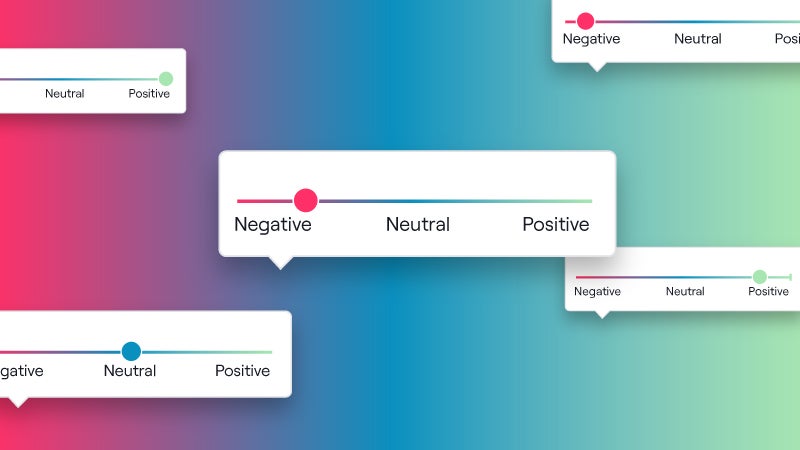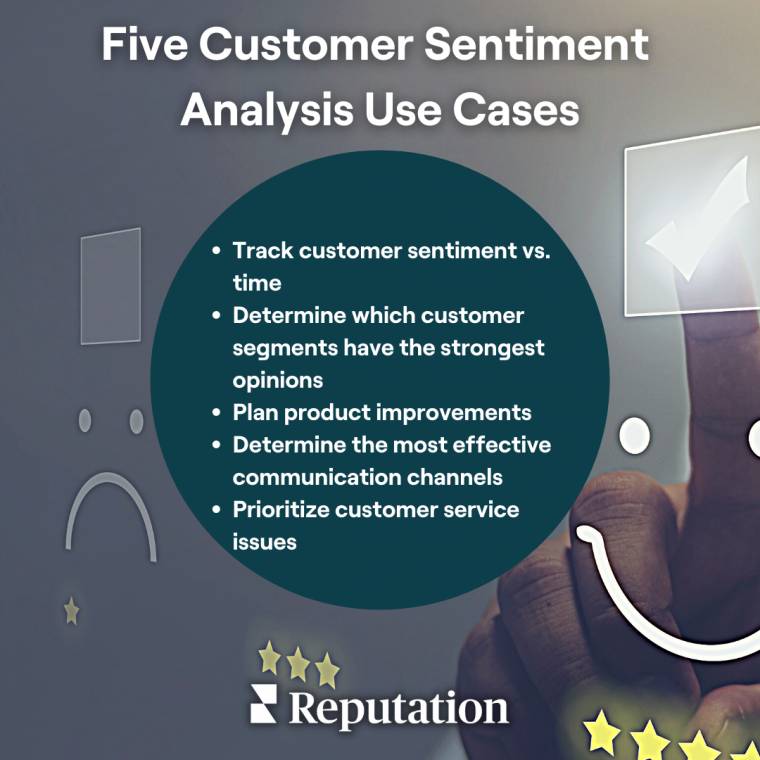5 Real-World Sentiment Analysis Use Cases
Reputation Staff Writer

Sentiment analysis attaches a metric to a snippet of data that conveys how positive or negative its connotation is. It’s deeper than the traditional customer survey that asks a participant to assign a value to a statement. The idea that “all press is good press” isn’t quite accurate for any business looking to stay successful. If your customer sentiment around your brand is universally poor, your business may be in trouble.
You can apply sentiment analysis to unstructured data, such as the text of an email, a Facebook comment or a tweet. Through machine learning algorithms, sentiment analysis becomes more exact as the models consumer and analyze and collect customer data.
In this article, we’ll cover everything you need to know about customer sentiment analysis. We’ll do so in the following sections:
- Benefits of Customer Sentiment Analysis
- Five Sentiment Analysis Use Cases
- How Reputation Can Help You Conduct Sentiment Analysis
Benefits of Customer Sentiment Analysis
Understanding and leveraging customer sentiment data is one of the best ways for your organization can grow. As MonkeyLearn reported, here some additional benefits of conducting customer sentiment analysis:
Enhance the customer experience. Monitoring both positive and negative sentiment from surveys responses is a pathway into what customers enjoy about your product or service. If you see trends within those responses, you can act on them to make real changes based on sentiment analysis. That will turn a potentially negative experience into a positive customer experience for anyone who interacts with your brand.
Improve your products and services. Not only can sentiment analysis capture customer complaints, but it can alert you to issues within your products or services. Customers will likely mention issues/bugs or specific needs in survey responses or social media posts.
Related: How to Ask Customers for Reviews
Monitor brand reputation. Tracking what customers are saying about your organization across the internet, you’ll get an accurate view of your brand reputation. By staying on top of your online reputation, you can get ahead of any issues that may harm your business.
Five Sentiment Analysis Use Cases
Businesses of every type can use sentiment analysis to gain deep insight into how their customers think and feel. But it’s important to understand examples of how to use this strategy in order to execute it successfully. Here are some examples of sentiment analysis use cases that your business can use.

1. Track Customer Sentiment vs. Time
If your current data gathering indicates people are happy with your products and services, that’s terrific. However, it can lead to complacency — sentiment analysis can prevent complacency by showing how customer sentiment tracks over time. For example, you could see an uptick in consumer sentiment and trace that data back to its most likely cause.
2. Determine Which Customer Segments Have the Strongest Opinions
Sentiment analysis can tell you which customers feel negatively about your brand for whatever reason. For example, you could find out that negative sentiment is coming from people who don’t like your returns process. Likewise, sentiment analysis can help you identify which customers are your strongest brand ambassadors.
3. Plan Product Improvements
How have customers reacted to your product’s new control layout? What specific product improvements put a smile on customers’ faces?
Sentiment analysis can use unstructured data to help you learn how people felt about your latest product release. This data could tell you that people love the product’s appearance, but find that it is difficult to use. Sentiment analysis can tell you over time what complaints about “ease of use” are related to.
4. Determine the Most Effective Communication Channels
While consistency is important across communication channels, you may find that people respond more positively on some channels than others. Maybe the percentage of positive tweets about your brand is higher than the percentage of positive Facebook comments. Consider why that result might be. Such information can help you analyze how you interact with customers on various platforms, and make changes as necessary.
5. Prioritize Customer Service Issues
Customer support tickets tend to be answered in order of submission, but is that the best approach? Companies can use sentiment analysis to put top-priority customer service tickets at the head of the queue. Done strategically, this can help companies quickly address negative feedback.
Related: Customer Perception: What It Is & How to Improve It
How Reputation Can Help You Conduct Sentiment Analysis
Getting started with conducting sentiment analysis requires that you analyze everywhere customers and potential leads are discussing your brand online. As we previously discussed, this includes:
- Social media
- All major online review sites
- Search results
- Business listings
- Custom survey data
This may produce an overwhelming amount of data. But Reputation offers sentiment analysis tools based in text analytics and deep learning. They will allow you to easily organize data in the best way to reveal your customer sentiment:
Word Cloud — Reputation offers advanced analytics that produce a visual representation of your company’s strengths and weaknesses. This can be viewed at a high level or for each location. See which words occur the most will give you an accurate read on how customers feel about your brand.
Tornado Chart — Reputation’s tornado chart is an alternate way to view those same analytics based on customer feedback across the web. This chart lists keywords vertically, with the most prominent term being listed in the longest bar at the top.
The bars shrink as they go down, which makes them resemble a tornado. This is also benchmarked against the industry for comparison. That gives you a better understanding of customer sentiment overall and for individual locations.
Reputation Score — The Reputation Score gives you a single number that lets you know how your brand is performing online. This is a real-time calculation based on a variety of factors that enables you to view and track sentiment. You can drill into this metric to see where your business is excelling and where there is room for improvement.
Flexible and Scalable Analytics — Reputation offers a unique set of analytics that you won’t find in other online reputation management solutions. You can customize your reports and views to obtain the most useful data that is specific to your business.
Sentiment analysis is an essential tool for improving your online reputation. That’s because it takes largely unstructured data and gives you actionable data that you can tactically and strategically address.
Reputation knows how to help customers find, choose and recommend your business, and we would be delighted to show you how. Our rich suite of products offers you an array of choices to get started with online reputation management. Contact us to get started today with your journey toward successful sentiment analysis.
Keep Reading: The 5 Must-Haves for Successful Reputation Experience Management
